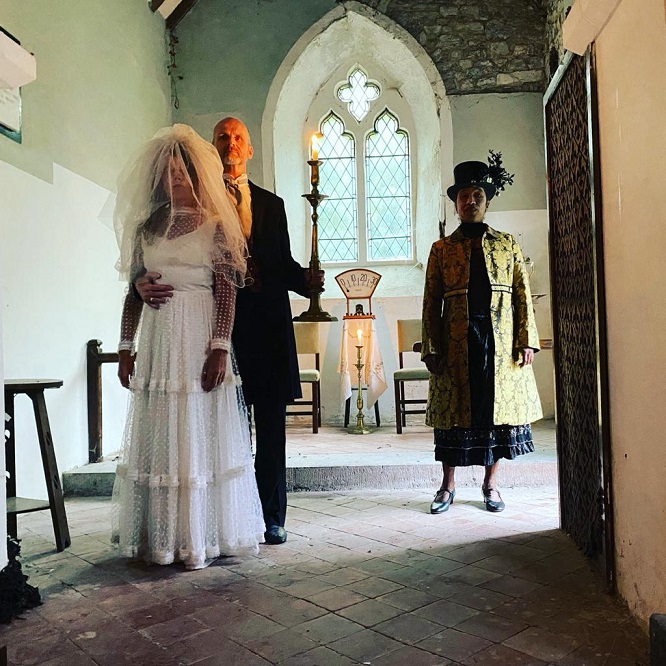Review: A Frequency At Lavernock/Amledd Yn Larnog is a compelling retelling of old south Wales’ stories

Jon Gower
The German physician and discoverer of ‘animal magnetism’ Franz Mesmer is the man behind, or within the word ‘mesmerising’ which the dictionary defines as capturing the complete attention of someone; transfix.’ The word seems perfect to describe the virtual reality film ‘A Frequency At Lavernock/Amledd Yn Larnog’ by Cardiff-based film-maker Tracy Spottiswoode which has been selected for this year’s Festival of International Virtual and Augmented Reality Stories (FIVARS) in Los Angeles, described by the Huffington Post as ‘the most cutting edge story telling festival in the world.’
The performance piece weaves together two local ghost stories, the words for which are projected onto the rocks beneath the performers’ feet. One tale tells the story of a lovestruck captain who is denied access to the love of his life by her father, a Colonel who wants someone better for his daughter. It’s a situation which leads to a fatal stabbing and consequent hauntings.
The other is the story of ‘The Captain’s Wife’ – a story about a captain who promises his wife a long sea journey, which pivots on the sailors’ superstition that a woman on board ship was unlucky, or, in this case, because she dies on board, that a dead woman is so much worse. This story gives its name to the popular pub at nearby Sully. As local legend has it her dead body was subsequently kept in a box, possibly made of lead, which was one day stolen as someone had mistaken it for treasure. It’s a macabre touch.
Gareth Clark is the pulse of the piece, a man in black, wearing a captain’s peaked hat to match who signals to two women, attracting them in with his own kind of magnetism. He moves and sways in time to a regular beat, set up by the arresting soundtrack by Marie Tueje, whose work was appeared in such award winning documentaries as the ‘The Living Thames.’
Morse Code
Tueje takes her aural cue from the first ever Morse Code wireless message, sent across a stretch of sea between Flat Holm island and Lavernock in Morse Code by Guglielmo Marconi in 1897. It, in turn, cues Clarke, his arms flailing slowly and sometimes wind-milling, as the man draws the two women towards him with his weird physical semaphore.
The crinolined women are danced into being by Marega Palser and Mary-Anne Roberts but made less corporeal by the simple elegance of their movements, even as they are summoned ever closer to him, like moths to a candle or ships to a wrecker’s light. But as if to thwart him, when they get up close to him they then move on, as if they have moved on through, in that way ghosts have. You know.
This being a VR experience, watching it with headset on and headphones glued over the ears, it allows the viewer to fully appreciate the landscape, seascape and indeed the skyscape in all directions, with perhaps the most striking element being the layered rocks of Lavernock, which are studded with fossil remains and where dinosaur bones have been disinterred, as well as their footprints revealed. This adds to the layering of the piece, the sense that stories are palimpsests, laid down one over the other to make up the texture of a place.

The stories are narrated in Welsh and English by Sharon Morgan, who adds just the right kind of spooky edge to the clarity of the telling. You can choose to read the text on the rocks, or ignore them by the tilt of a head but of course they’ll work perfectly for deaf people entering this odd, seaside world, and indeed the unsettling aspects of the VR representation, where you feel disengaged from your own body, spatially disorientated in the new world conjured into being by someone filming the action in both directions through 180 degrees and then splicing them together through the magic of software to give you a complete world in all directions, in this case with seagulls winging through overhead.
The film is part of a bigger project which draws on the plentiful well of local stories and avails itself of the area’s beautiful ancient churches such as St Lawrence at Lavernock and the Celtic instinct for spinning a good yarn, and is in part inspired by the tradition of European fairytale films.
But ‘A Frequency At Lavernock/Amledd Yn Larnog’ also sees Spottiswoode return to her early days in immersive theatre, dressing the open-air “set” with some flotsam and jetsam, evidence of wrecks. She also harnesses the off-kilter power of VR to tell her simply compelling and compellingly simple old south Wales’ stories, now retold in a way allowed to her by the evolving technology of the twenty first century.
A Frequency at Lavernock/Amledd yn Larnog is is being shown at FIVARS Festival online until 2 November and you can watch it here…..
Support our Nation today
For the price of a cup of coffee a month you can help us create an independent, not-for-profit, national news service for the people of Wales, by the people of Wales.





